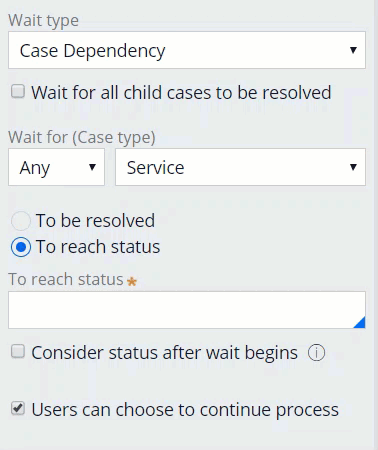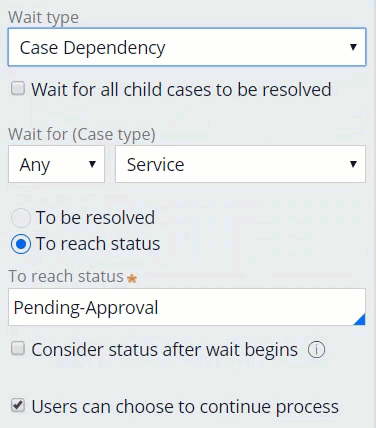
Case workflow dependency
You can enforce dependencies using the Wait step. The Wait step allows you to pause and resume case processing when the case meets conditions that you define. For example, when a customer submits an order to purchase a mutual fund, the processing is paused until the end of the day, and then the fund value is calculated.
Wait types
The Wait step can be configured to pause case processing based on Wait type: Case Dependency or Timer.
Case Dependency
The Case Dependency wait type pauses case processing of a parent case until the child case dependency resolves.
You create a case dependency by adding a Wait step to the parent case. When a parent case reaches the Wait step, the case pauses until all child cases or any child case of a given type reach a defined status. The status could be a standard status like Pending-Approval or a custom status defined in your application. You can also set the Wait step to To be resolved, where a case is resolved when the case status is set to a value that starts with the word Resolved. For example, when a parent case reaches the Wait step, the case pauses until one or all child cases are resolved.
Note: A hierarchical relationship between cases, such as parent and child cases, must exist for the wait shape to consider the dependency at runtime.
You can set the case to consider only the current status or status changes after the case reaches the Wait shape. You can also allow users to cancel the wait conditions and continue processing a case.
Timer
The Timer wait type pauses a case until the Set date/time interval expires or until a Reference date/time is reached.
You can configure the Wait step to pause the process for a fixed interval (hours/minutes) or based on the value of a property reference. You either specify a specific length of time the case should pause, or use a variable that contains a date when the case should resume. For example, with an accident claim, you may give someone 24 hours to upload pictures for the accident. You want to pause the case until the wait time has elapsed.
Wait step versus user action
It is important to recognize the distinction between deliberately pausing a case by inserting a Wait step, and delays in case processing that occur while awaiting user action on assignment steps that must be completed before a case can proceed.
Examples of delays in case processing while awaiting user action include an expense report case that is delayed while awaiting a decision on an Approve/Reject step from the manager of the Finance team, or the start of an automobile claims case being delayed because the user has yet to submit the accident photos required to complete a Collect information step in the Create stage.
In both examples, case processing is delayed until user actions are completed on an assignment step, rather than being deliberately paused by using a Wait step.
Check your knowledge with the following interaction:
This Topic is available in the following Module:
If you are having problems with your training, please review the Pega Academy Support FAQs.
Want to help us improve this content?


